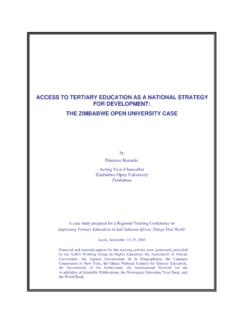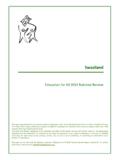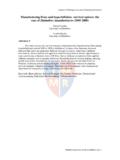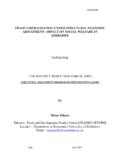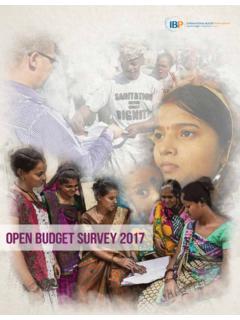Transcription of Agricultural input subsidies in Sub-Saharan Africa
1 Published by:Ministry of Foreign Affairs of DenmarkEvaluation DepartmentAsiatisk plads 21448 Copenhagen KDenmarkE-mail: publication can be downloaded : 978-87-7087-586-8 ISBN: 978-87-7087-587-5 (internet version)Other Evaluation Studies2007/1: Assistance to Development Research2007/2: Synthesis of Evaluations on Technical Assistance2007/3: Evaluating the Impact of Rural Roads in Nicaragua2008/1: Synthesis of Evaluations of HIV/AIDS Assistance2008/2: Synergies between Bilateral and Multilateral Activities2008/3: Assessing Multilateral Organisation Effectiveness2008/4: Economic Empowerment of Women2008/5: Public Private Partnership Programme2009/1: Evaluating Aid Effectiveness in the Aggregate: Methodological Issues2009/2: Addressing the Underlying and Basic Causes of Child Undernutrition in Developing Countries: What Works and Why?2009/3: Experiences with Conducting Evaluations Jointly with Partner Countries2009/4: Synthesis of Impact Evaluations of Microcredit2009/5: Synthesis of Evaluations on Support to Business Development2010/1: Evaluating Aid Effectiveness in the Aggregate: A critical assessment of the evidence2010/2: Gender and Value Chain Development2011/1: CCPA s Open Fun Football Schools ProgrammeEVALUATION STUDY2011/2 Agricultural input subsidies in Sub-Saharan Africa Evaluation Study Agricultural input subsidies in Sub-Saharan Africa Kenneth Baltzer, Assistant Professor, PhD.
2 Henrik Hansen, Professor, PhD. Institute of Food and Resource Economics, university of Copenhagen Rolighedsvej 25, 1958 Frederiksberg C. _____ Useful comments and suggestions from Senior Advisor Jens Kovsted, Institute of Food and Resource Ec onomics, are gratefully acknowledged. The views expressed are those of the authors and do not necessarily represent the views of the Ministry of Foreign Affairs of Denmark. Errors and omissions are the responsibility of the authors. Table of Contents 1. Introduction .. 1 2. Agricultural input 1 Agricultural 1 Universal vs. smart input subsidy 2 3. Methodology .. 3 Assessment 3 3 Equity .. 6 6 The political economy of input 7 Structure of the study .. 7 Selection of cases and 8 4. Selected input subsidy programmes in Sub-Saharan 8 Malawi, Agricultural input Support Programme/Farm input Support Programme (AISP)..10 Outcome ..10 Scope ..12 Targeting ..12 Exit Assessment.
3 14 Zambia, Fertilizer Support Programme (ZFSP)..15 Outcome ..16 Scope ..17 Targeting ..17 Exit Assessment ..19 Ghana, Fertilizer Subsidy Programme (GFSP)..20 Outcome ..21 Scope ..21 Targeting ..22 Exit Assessment ..23 Tanzania, National Agricultural input Voucher Scheme (NAIVS)..24 Outcome ..24 Scope ..24 Targeting ..25 Exit Assessment ..26 5. Lessons Learned ..27 Delivery ..29 Exit 6. 7. List of Abbreviations AISP Agricultural input Support Programme, Malawi AU African Union CAN Calcium Ammonium Nitrate CNFA Citizens Network for Foreign Affairs GDP Gross Domestic Product GFSP Fertilizer Subsidy Programme, Ghana GHS Ghanaian cedis NAIVS National Agricultural input Voucher Scheme, Tanzania NDP National Democratic Congress NEPAD New Partnership for African Development NGO Non-Governmental Organisation NMB National Microfinance Bank NPK Nitrogen Phosphorous Kalium (Potassium) NPP New Patriotic Party MK Malawian Kwacha OPV Open Pollinated Variety SSA Sub-Saharan Africa USD US Dollar VDC Village Development Committee VVC Village Voucher Committee ZFSP Fertilizer Support Programme, Zambia ZMK Zambian Kwacha 1 1.
4 Introduction The purpose of this study is to evaluate the experiences of recent applications of Agricultural input subsidies in Sub-Saharan Africa (SSA). Subsidising Agricultural inputs is controversial. On the one hand, Agricultural input use in SSA is very low by international standards, and the hope is that subsidies may induce farmers to adopt the use of inputs and thereby increase Agricultural productivity. On the other hand, many economists argue that Agricultural subsidies of all kinds are expensive, mainly benefit the wrong people, and distort Agricultural markets by encouraging farmers to overusing whatever is subsidised. The recent input subsidy programmes reviewed in this study attempt to meet these challenges by introducing so-called smart subsidies , which are specifically designed to maximise effects at the lowest cost (we will discuss smart subsidies in more detail below). The overall objective of the evaluation study is to ..provide an assessment of smart subsidy programmes in SSA, focusing on obtained results as well as the way results have (or have not) been achieved, hindering and enabling factors, pre-conditions, etc.
5 (Terms of Reference, included in the Appendix). We evaluate the overall performance of selected input subsidy programmes, identify the most important factors affecting programme performance, and outline areas where knowledge is scarce or non-existent. We have selected Agricultural input subsidy programmes in four SSA countries, Malawi, Zambia, Ghana and Tanzania to form the basis for the evaluation study. The need to assess the subsidy programmes in some detail dictates our focus on relatively few cases. The Malawi programme has received a great deal of attention as an example of a successful input subsidy programme. It is massive in scale, targeting is based on a voucher system, and delivery of inputs to farmers is largely state-managed. It is also reasonably well documented in the literature. The large scale programme in Zambia provides an example of an alternative non-voucher targeting system and features state-driven delivery. The Ghana case demonstrates a relatively small programme with a very market oriented delivery system, and the Tanzania case provides insights into the targeting performance of a voucher scheme.
6 Together, the selected cases provide considerable breadth in terms of differences in the scope, design, implementation and outcome of the programmes, as well as surrounding conditions. The evaluation study is organised as follows: In the next section we discuss what is meant by smart subsidies . The economic philosophy which is the foundation of the concept of smart subsidies also forms the basis for our methodology as outlined in section 3. Section 4 evaluates each of the four cases and section 5 summarises the lessons learned and section 6 concludes. 2. Agricultural input subsidies Agricultural inputs We use Agricultural inputs as a common term for a range of materials, which may be used to enhance Agricultural productivity. Most important among these are fertilizers and improved seeds. All the programmes reviewed subsidise fertilizers, and most of them combine fertilizers with improved seeds in small packages. 2 The use of Agricultural inputs is fundamental in modern agriculture in developed countries, and they were a primary ingredient in the green revolution that swept through Asia and Latin America during the 60s and 70s.
7 However, the green revolution largely by-passed SSA, and the use of Agricultural inputs remains very low. In 2002-2003 Sub-Saharan African farmers used on average 9 kg of fertilizers per ha of arable land compared to 100 kg per ha in South Asia, 135 in Southeast Asia and 73 in Latin America (Crawford et al, 2006). While Agricultural production and productivity soared in Asia and Latin America during the last four decades, they have largely stagnated in Africa , resulting in a rising dependency on imported grains and an increase in the number of undernourished people (Wiggins and Brooks, 2010; Future Agricultures, 2010). Universal vs. smart input subsidy programmes Many African countries, including Kenya, Tanzania, Malawi, Zimbabwe and Zambia pursued large scale universal subsidy programmes from the 1960 s up through the 1980 s (Dorward, 2009). These programmes were characterised by a government-controlled input (and output) marketing system, in which farmers were supplied with Agricultural inputs at controlled and subsidised prices, and often on heavily subsidised credit.
8 The experiences under these programmes were mixed. The programmes succeeded in raising input use by farmers and increasing Agricultural productivity in many cases. However, they were extremely expensive, most subsidies tended to benefit relatively well-off and better connected farmers, and the advances in Agricultural productivity were dependent on continued government support. Further, the fertilizer subsidy programmes were prone to inefficiencies arising from high administrative costs, government monopolies and political manipulation (Banful, 2010b). As the subsidy programmes were dismantled and input markets liberalised as a part of the structural adjustment process in the 1980 s and 1990 s, input use and Agricultural productivity declined (Crawford et al, 2006). After a period of liberalised input markets by the end of the last century, new subsidy programmes began to emerge in several African countries. The Malawian government pioneered the return to large-scale subsidies in 1998, when it began distributing free fertilizer to farmers (Banful, 2010b).
9 Other countries, such as Nigeria, Zambia, Tanzania, Kenya, Ghana soon followed Malawi s example. In 2006, Abuja, Nigeria, hosted the Africa Fertilizer Summit under the auspices of the African Union (AU), the New Partnership for African Development (NEPAD) and the Government of Nigeria (Yawson, 2010). An important output of that summit was the Abuja Declaration on Fertilizer for African Green Revolution, in which AU member states set out to increase fertilizer intensity to an average of 50 kg/ha by 2015. One of the instruments in a five point action plan was to implement smart subsidy programmes to improve access to fertilizers for small-holder farmers. Smart subsidy programmes are meant to address the shortcomings of the universal subsidies . To be smart , subsidy programmes should adhere to a number of design principles, which can be summarised under the following headlines (Minde et al, 2008; Tiba, 2009): Targeting specific farmers. Smart subsidies should be targeted specifically at farmers, who do not already apply Agricultural inputs, as well as the poorest and most vulnerable households.
10 This reduces the risks of displacing commercial (non-subsidised) input sales and promotes pro-poor growth. Market-based solutions. Smart subsidy programmes should utilise and support the further development of existing private input supply networks, rather than supplant them with state-controlled distribution systems. This enhances the efficiency of input delivery as well as increases the likelihood that the programme has a sustained impact after its termination. 3 Exit strategy. Smart subsidy programmes should devise credible exit strategies to put a time limit on the support. This is primarily to reduce the risks that the programme becomes hijacked by political interests (Dorward, 2009) and to facilitate long term sustainability. If stakeholders expect the support to continue indefinitely they are less likely to prepare for self-sustained use of inputs on market terms. Also, a firm exit strategy helps control the costs of the programme. The three characteristics are largely complementary.










